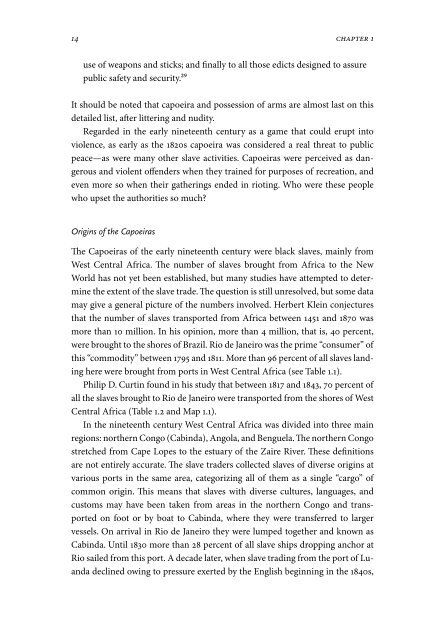A Collision of Cultures in the Brazilian Battle Dance - Capoeira Music
A Collision of Cultures in the Brazilian Battle Dance - Capoeira Music
A Collision of Cultures in the Brazilian Battle Dance - Capoeira Music
You also want an ePaper? Increase the reach of your titles
YUMPU automatically turns print PDFs into web optimized ePapers that Google loves.
chapter<br />
use <strong>of</strong> weapons and sticks; and f<strong>in</strong>ally to all those edicts designed to assure<br />
public safety and security.29<br />
it should be noted that capoeira and possession <strong>of</strong> arms are almost last on this<br />
detailed list, after litter<strong>in</strong>g and nudity.<br />
regarded <strong>in</strong> <strong>the</strong> early n<strong>in</strong>eteenth century as a game that could erupt <strong>in</strong>to<br />
violence, as early as <strong>the</strong> 1820s capoeira was considered a real threat to public<br />
peace—as were many o<strong>the</strong>r slave activities. <strong>Capoeira</strong>s were perceived as dangerous<br />
and violent <strong>of</strong>fenders when <strong>the</strong>y tra<strong>in</strong>ed for purposes <strong>of</strong> recreation, and<br />
even more so when <strong>the</strong>ir ga<strong>the</strong>r<strong>in</strong>gs ended <strong>in</strong> riot<strong>in</strong>g. Who were <strong>the</strong>se people<br />
who upset <strong>the</strong> authorities so much?<br />
Orig<strong>in</strong>s <strong>of</strong> <strong>the</strong> <strong>Capoeira</strong>s<br />
The <strong>Capoeira</strong>s <strong>of</strong> <strong>the</strong> early n<strong>in</strong>eteenth century were black slaves, ma<strong>in</strong>ly from<br />
West Central africa. The number <strong>of</strong> slaves brought from africa to <strong>the</strong> new<br />
World has not yet been established, but many studies have attempted to determ<strong>in</strong>e<br />
<strong>the</strong> extent <strong>of</strong> <strong>the</strong> slave trade. The question is still unresolved, but some data<br />
may give a general picture <strong>of</strong> <strong>the</strong> numbers <strong>in</strong>volved. Herbert Kle<strong>in</strong> conjectures<br />
that <strong>the</strong> number <strong>of</strong> slaves transported from africa between 1451 and 1870 was<br />
more than 10 million. <strong>in</strong> his op<strong>in</strong>ion, more than 4 million, that is, 40 percent,<br />
were brought to <strong>the</strong> shores <strong>of</strong> Brazil. rio de Janeiro was <strong>the</strong> prime “consumer” <strong>of</strong><br />
this “commodity” between 1795 and 1811. More than 96 percent <strong>of</strong> all slaves land<strong>in</strong>g<br />
here were brought from ports <strong>in</strong> West Central africa (see table 1.1).<br />
philip d. Curt<strong>in</strong> found <strong>in</strong> his study that between 1817 and 1843, 70 percent <strong>of</strong><br />
all <strong>the</strong> slaves brought to rio de Janeiro were transported from <strong>the</strong> shores <strong>of</strong> West<br />
Central africa (table 1.2 and Map 1.1).<br />
<strong>in</strong> <strong>the</strong> n<strong>in</strong>eteenth century West Central africa was divided <strong>in</strong>to three ma<strong>in</strong><br />
regions: nor<strong>the</strong>rn Congo (Cab<strong>in</strong>da), angola, and Benguela. The nor<strong>the</strong>rn Congo<br />
stretched from Cape Lopes to <strong>the</strong> estuary <strong>of</strong> <strong>the</strong> Zaire river. These def<strong>in</strong>itions<br />
are not entirely accurate. The slave traders collected slaves <strong>of</strong> diverse orig<strong>in</strong>s at<br />
various ports <strong>in</strong> <strong>the</strong> same area, categoriz<strong>in</strong>g all <strong>of</strong> <strong>the</strong>m as a s<strong>in</strong>gle “cargo” <strong>of</strong><br />
common orig<strong>in</strong>. This means that slaves with diverse cultures, languages, and<br />
customs may have been taken from areas <strong>in</strong> <strong>the</strong> nor<strong>the</strong>rn Congo and transported<br />
on foot or by boat to Cab<strong>in</strong>da, where <strong>the</strong>y were transferred to larger<br />
vessels. on arrival <strong>in</strong> rio de Janeiro <strong>the</strong>y were lumped toge<strong>the</strong>r and known as<br />
Cab<strong>in</strong>da. Until 1830 more than 28 percent <strong>of</strong> all slave ships dropp<strong>in</strong>g anchor at<br />
rio sailed from this port. a decade later, when slave trad<strong>in</strong>g from <strong>the</strong> port <strong>of</strong> Luanda<br />
decl<strong>in</strong>ed ow<strong>in</strong>g to pressure exerted by <strong>the</strong> english beg<strong>in</strong>n<strong>in</strong>g <strong>in</strong> <strong>the</strong> 1840s,






